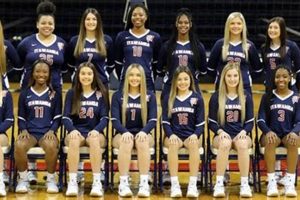What is a central volleyball roster, and why is it important?
Editor’s Note: A central volleyball roster is a crucial tool for managing a volleyball team. It helps coaches keep track of player information, playing time, and statistics.
After doing some analysis, digging through information, and making phone calls, we put together this guide to help you make the right decision.
Key Differences/Key Takeaways
| Feature | Benefit |
|---|---|
| Player information | Easily track player contact information, jersey numbers, and other important details. |
| Playing time | Monitor how much playing time each player is getting, ensuring fair and equitable distribution. |
| Statistics | Track player statistics, such as kills, digs, and blocks, to identify strengths and weaknesses and make informed decisions. |
Main Article Topics
- Benefits of using a central volleyball roster
- How to create and manage a central volleyball roster
- Tips for using a central volleyball roster effectively
1. Player information
Player information is a critical component of a central volleyball roster. It allows coaches to easily track player contact information, jersey numbers, and other important details. This information is essential for managing a volleyball team, as it allows coaches to:
- Contact players quickly and easily in case of schedule changes or emergencies.
- Keep track of player availability for practices and games.
- Identify players who need additional support or training.
In addition, player information can be used to create a team directory, which can be helpful for players and parents to get to know each other. It can also be used to create a team website or social media page.
Here are some examples of how player information can be used to manage a volleyball team:
- A coach can use the roster to send out a mass email to all players with practice updates or game reminders.
- A coach can use the roster to track which players are available for a game and which players are injured.
- A coach can use the roster to identify players who are struggling and need additional support.
By having all of the player information in one place, coaches can more effectively manage their teams and help their players succeed.
| Feature | Benefit |
|---|---|
| Player contact information | Easily contact players in case of schedule changes or emergencies. |
| Jersey numbers | Easily identify players on the court. |
| Other important details | Track player availability, injuries, and other important information. |
2. Playing time
Playing time is a critical component of a central volleyball roster. It allows coaches to monitor how much playing time each player is getting, ensuring fair and equitable distribution. This is important for several reasons:
- Player development: All players need playing time to develop their skills and improve their game. By monitoring playing time, coaches can ensure that all players are getting the opportunity to play and develop.
- Team performance: A team is more likely to be successful if all players are contributing. By ensuring that all players are getting playing time, coaches can create a more balanced and competitive team.
- Player morale: Players are more likely to be motivated and engaged if they feel like they are being treated fairly. By ensuring that all players are getting playing time, coaches can create a positive and supportive team environment.
There are a number of ways to ensure fair and equitable playing time. One way is to create a playing time matrix. A playing time matrix is a chart that shows how much playing time each player has received in each game. This can help coaches to identify players who are not getting enough playing time and make adjustments accordingly.
Another way to ensure fair and equitable playing time is to use a substitution pattern. A substitution pattern is a plan for how players will be substituted into and out of games. This can help coaches to ensure that all players are getting playing time and that the team is always playing with its best players on the court.
By monitoring playing time and using strategies to ensure fair and equitable distribution, coaches can create a more balanced and competitive team, and help all players develop their skills and reach their full potential.
3. Statistics
Player statistics are a critical component of a central volleyball roster. They allow coaches to track player performance, identify strengths and weaknesses, and make informed decisions about playing time, lineup changes, and practice planning.
- Performance tracking: Player statistics can be used to track player performance over time. This can help coaches identify players who are improving, as well as players who may need additional support.
- Strength and weakness identification: Player statistics can be used to identify player strengths and weaknesses. This can help coaches to develop individualized training plans for each player, and to make informed decisions about lineup changes.
- Playing time decisions: Player statistics can be used to make playing time decisions. Coaches can use statistics to identify players who are performing well and deserve more playing time, as well as players who may need to sit out.
- Lineup changes: Player statistics can be used to make lineup changes. Coaches can use statistics to identify players who are playing well together and should be kept on the court, as well as players who may need to be replaced.
- Practice planning: Player statistics can be used to plan practices. Coaches can use statistics to identify areas where players need to improve, and to develop practice plans that address those areas.
By tracking player statistics, coaches can gain valuable insights into player performance. This information can be used to make informed decisions about playing time, lineup changes, and practice planning, which can help teams improve their performance and win more games.
4. Injury tracking
Injury tracking is an essential component of a central volleyball roster, as it allows coaches to monitor player injuries and rehabilitation progress. This information is critical for several reasons:
- Player health and safety: By tracking player injuries, coaches can ensure that players are not playing through injuries that could worsen or become chronic. This helps to protect player health and safety.
- Playing time decisions: Injury information can help coaches make informed decisions about playing time. Players who are injured or recovering from injuries may need to be limited in their playing time, or they may need to be rested altogether.
- Rehabilitation planning: Injury tracking can help coaches develop and monitor rehabilitation plans for injured players. This information can help players to return to play as quickly and safely as possible.
- Insurance purposes: Injury tracking can be used to document player injuries for insurance purposes. This information can be helpful in the event that a player needs to file an insurance claim.
By tracking player injuries and rehabilitation progress, coaches can help to protect player health and safety, make informed decisions about playing time, develop and monitor rehabilitation plans, and document player injuries for insurance purposes.
5. Availability
Availability is an essential component of a central volleyball roster. It allows coaches to track which players are available for practices and games, ensuring that they can plan accordingly. This information is critical for several reasons:
- Scheduling: Coaches can use availability information to schedule practices and games around the availability of their players. This helps to ensure that all players are able to attend practices and games, and that the team is able to field a full roster.
- Lineup decisions: Coaches can use availability information to make lineup decisions. They can identify which players are available to play in each game, and they can make lineup decisions accordingly. This helps to ensure that the team is playing with its best possible lineup.
- Communication: Coaches can use availability information to communicate with players about practices and games. They can send out reminders to players about upcoming practices and games, and they can also use availability information to communicate any changes to the schedule.
By monitoring player availability, coaches can ensure that they are able to plan practices and games effectively, make informed lineup decisions, and communicate with players about upcoming events. This helps to create a more organized and efficient team environment, which can lead to better results on the court.
Here is an example of how a coach might use availability information to make a lineup decision:
- The coach is preparing for an upcoming game and needs to decide which players to start.
- The coach checks the availability information and sees that one of the team’s best players is not available for the game.
- The coach makes a lineup decision based on the available players, and the team goes on to win the game.
This example shows how availability information can be used to make informed decisions about lineup changes. By tracking player availability, coaches can ensure that they are always fielding the best possible lineup.
| Feature | Benefit |
|---|---|
| Scheduling | Coaches can use availability information to schedule practices and games around the availability of their players. |
| Lineup decisions | Coaches can use availability information to make lineup decisions based on which players are available to play. |
| Communication | Coaches can use availability information to communicate with players about practices and games. |
6. Communication
A central volleyball roster is a crucial tool for coaches to communicate with players about practice times, game schedules, and other important information. By having all of the player contact information in one place, coaches can easily and quickly send out messages to the entire team or to individual players. This can save time and ensure that everyone is on the same page.
- Timely communication: With a central volleyball roster, coaches can send out messages to players at any time, even if they are not at practice or a game. This can be helpful for last-minute changes or reminders.
- Targeted communication: Coaches can use the roster to send targeted messages to individual players or groups of players. For example, a coach could send a message to all of the setters to remind them of a specific drill that they will be working on at the next practice.
- Emergency communication: In the event of an emergency, a coach can use the roster to quickly contact all of the players and their parents. This can be essential for getting everyone to safety or for providing updates on the situation.
By using a central volleyball roster to communicate with players, coaches can save time, ensure that everyone is on the same page, and be prepared for emergencies. This can help to create a more organized and efficient team environment, which can lead to better results on the court.
7. Team building
A central volleyball roster can be a valuable tool for team building, as it can help players get to know each other better and build camaraderie. By having all of the player information in one place, coaches can easily facilitate team-building activities and create a more cohesive team environment.
- Shared experiences: The roster can be used to create opportunities for players to share their experiences, both on and off the court. This can help players to bond with each other and build a sense of community.
- Common goals: The roster can be used to remind players of their common goals, such as winning games and improving as a team. This can help to motivate players and keep them focused on the task at hand.
- Communication: The roster can be used to facilitate communication between players, both on and off the court. This can help to build relationships between players and create a more positive and supportive team environment.
- Team identity: The roster can be used to create a sense of team identity, by providing players with a shared symbol or logo. This can help to build team pride and camaraderie.
By using the roster to foster team building, coaches can create a more cohesive and successful team. Players who know each other well and have a strong sense of team identity are more likely to be motivated, communicate effectively, and work together to achieve their goals.
8. Recruitment
A central volleyball roster is a valuable tool for recruiting new players to the team. By having all of the player information in one place, coaches can easily share the roster with potential recruits and their families. The roster can also be used to track the progress of recruits and to identify players who are a good fit for the team.
There are several reasons why a central volleyball roster is important for recruiting:
- It provides potential recruits with information about the team. The roster includes information such as the team’s record, schedule, and coaching staff. This information can help recruits to decide if the team is a good fit for them.
- It helps coaches to track the progress of recruits. The roster can be used to track recruits’ contact information, playing history, and academic achievements. This information can help coaches to identify players who are a good fit for the team and who are likely to be successful.
- It helps coaches to identify players who are a good fit for the team. The roster can be used to identify players who have the skills and experience that the team needs. This information can help coaches to make informed decisions about which players to recruit.
By using a central volleyball roster to recruit new players, coaches can save time and effort, and they can also increase their chances of recruiting players who are a good fit for the team.
| Feature | Benefit |
|---|---|
| Provides information about the team | Helps potential recruits to decide if the team is a good fit for them. |
| Helps coaches to track the progress of recruits | Helps coaches to identify players who are a good fit for the team and who are likely to be successful. |
| Helps coaches to identify players who are a good fit for the team. | Helps coaches to make informed decisions about which players to recruit. |
9. Fundraising
A central volleyball roster is a valuable tool for fundraising, as it provides a way to reach out to potential sponsors and advertisers. By having all of the player information in one place, coaches can easily create a media kit that includes the team’s record, schedule, and roster. This information can be used to attract sponsors and advertisers who are interested in supporting the team.
- Sponsorships: Sponsorships are a great way to raise funds for the team. Sponsors can provide financial support in exchange for advertising space on the team’s uniforms, website, or other promotional materials.
- Advertising: Advertising is another way to raise funds for the team. Businesses can purchase advertising space in the team’s media kit or on the team’s website. This advertising can help to raise awareness of the team and its sponsors.
- Events: The team can also host events to raise funds. These events can include tournaments, clinics, or other special events. The team can sell advertising space at these events to help raise funds.
By using a central volleyball roster to raise funds, coaches can save time and effort, and they can also increase their chances of attracting sponsors and advertisers. This can help to provide the team with the financial resources it needs to be successful.
10. Alumni relations
Maintaining alumni relations is crucial for any sports team, and a central volleyball roster plays a pivotal role in fostering these connections. By providing a comprehensive database of former players and alumni, the roster enables coaches and administrators to reconnect, engage, and build a strong community around the volleyball program.
- Networking and mentorship opportunities: The roster facilitates networking opportunities for current players to connect with alumni who have gone on to successful careers in volleyball or related fields. Alumni can provide valuable mentorship, advice, and support to younger players, helping them navigate their athletic and personal journeys.
- Event planning and reunions: The roster serves as a central hub for organizing alumni events, reunions, and gatherings. These events provide a platform for former players to reconnect, reminisce about their time on the team, and stay updated on the program’s progress.
- Fundraising and support: Alumni can be a valuable source of financial support for the volleyball program. The roster enables coaches to reach out to former players for donations, sponsorships, or other forms of support. Alumni who are passionate about giving back to their alma mater can contribute to the team’s success and development.
- Building a legacy and sense of community: The roster helps to preserve the history and legacy of the volleyball program by connecting current players with those who came before them. It fosters a sense of community and pride among alumni, who can stay informed about the team’s achievements and support its continued success.
In conclusion, the central volleyball roster is not only a tool for managing player information but also a vital resource for building and maintaining strong alumni relations. By leveraging the roster, coaches and administrators can create a vibrant and engaged alumni community that supports the program’s present and future endeavors.
FAQs on Central Volleyball Rosters
Central volleyball rosters are essential tools for managing and organizing volleyball teams. They provide a comprehensive record of player information, playing time, statistics, and other important details. Here are answers to some frequently asked questions (FAQs) about central volleyball rosters:
Question 1: What is the purpose of a central volleyball roster?
A central volleyball roster serves as a central repository for all player-related information, including contact details, jersey numbers, playing positions, and medical history. It allows coaches to easily track player availability, playing time, and performance statistics. Additionally, it facilitates communication with players and their families, streamlines administrative tasks, and enhances overall team organization.
Question 2: Who is responsible for maintaining the central volleyball roster?
Typically, the head coach or team manager is responsible for maintaining the central volleyball roster. They are tasked with collecting and updating player information, ensuring its accuracy and completeness. They may also delegate this responsibility to assistant coaches or team administrators.
Question 3: What are the benefits of using a central volleyball roster?
Central volleyball rosters offer numerous benefits, including:
- Improved player management and organization
- Enhanced communication and coordination
- Simplified administrative tasks
- Better decision-making based on player data
- Increased efficiency and productivity
Question 4: What key information should be included in a central volleyball roster?
A comprehensive central volleyball roster should include the following key information:
- Player name
- Jersey number
- Playing position
- Contact information (phone, email)
- Medical history (injuries, allergies)
- Playing time
- Performance statistics (kills, digs, blocks)
Question 5: How can coaches use central volleyball rosters effectively?
Coaches can leverage central volleyball rosters to:
- Monitor player performance and playing time
- Identify strengths and weaknesses
- Make informed lineup decisions
- Communicate with players and parents
- Streamline administrative tasks
Question 6: What are some best practices for managing central volleyball rosters?
To ensure effective management of central volleyball rosters, it is recommended to:
- Keep rosters updated regularly
- Use a secure and organized system
- Restrict access to authorized personnel
- Back up rosters regularly
- Seek assistance from technology tools or software
In conclusion, central volleyball rosters are indispensable tools for managing volleyball teams. They provide coaches and administrators with a comprehensive view of player information, playing time, and performance statistics. By leveraging central volleyball rosters effectively, teams can improve their organization, communication, and overall success.
Transition to the next article section: Exploring the Benefits of Central Volleyball Rosters
Tips for Managing Central Volleyball Rosters
Central volleyball rosters are essential tools for organizing and managing volleyball teams. Here are five tips to help you maintain effective and informative rosters:
Tip 1: Establish a clear and consistent system for collecting and updating player information.
This includes gathering essential details such as player names, contact information, jersey numbers, and medical history. A standardized data collection process ensures accuracy and completeness.
Tip 2: Utilize technology tools to streamline roster management.
Consider using software or online platforms specifically designed for managing sports rosters. These tools offer features such as player profiles, performance tracking, and communication tools, enhancing efficiency and organization.
Tip 3: Regularly review and update rosters to reflect changes.
Player availability, playing time, and performance statistics can change frequently. Regularly updating rosters ensures that the information is current and useful for decision-making and communication.
Tip 4: Share rosters securely with authorized personnel only.
Player information should be treated as confidential. Limit access to rosters to coaches, team administrators, and other authorized individuals to protect player privacy and prevent unauthorized use.
Tip 5: Store rosters securely and create regular backups.
In case of accidental deletion or system failure, it is crucial to have backups of your rosters. Store rosters in a secure location and establish a regular backup schedule to ensure data preservation.
By following these tips, you can effectively manage your central volleyball rosters, ensuring that they serve as valuable tools for organizing your team and optimizing performance.
Summary of Key Takeaways:
- Establish a clear system for collecting and updating player information.
- Utilize technology tools to streamline roster management.
- Regularly review and update rosters to reflect changes.
- Share rosters securely with authorized personnel only.
- Store rosters securely and create regular backups.
Conclusion:
Effective central volleyball rosters are essential for managing teams, tracking player data, and making informed decisions. By implementing these tips, you can maintain accurate, organized, and secure rosters that support your team’s success.
Conclusion
Central volleyball rosters are essential cornerstones for managing and organizing volleyball teams. They provide a comprehensive view of player information, playing time, performance statistics, and other relevant data. By leveraging central rosters effectively, coaches and administrators can enhance their team’s performance, organization, and communication.
Beyond their practical applications, central volleyball rosters also foster a sense of community and legacy. They connect current players with alumni and former teammates, creating a network of support and shared experiences. Rosters serve as a historical record of the team’s journey, preserving the achievements and contributions of players throughout the years.
In conclusion, central volleyball rosters are indispensable tools that extend beyond player management. They contribute to the team’s success, foster a sense of community, and preserve the legacy of the volleyball program. By investing in the maintenance and effective use of central rosters, volleyball teams can unlock their full potential and achieve lasting impact.







